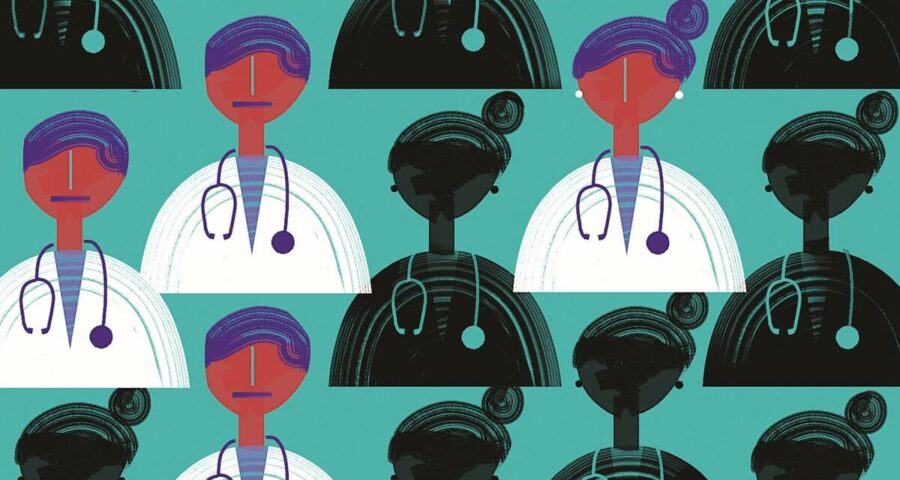We must identify areas in clinical care that can be delegated to health workers, guide them to triage the sick, and train doctors in other specialities in critical care.
(Written by Suravi Sharma Kumar)
In healthcare, there is no equivalence between a doctor and someone who is not. Patient safety requires doctors to step in when a complex problem or uncertainty over treatment arises. But considering the current shortage of doctors (and nurses, paramedics, assistants and so on) in the midst of a pandemic that has spread into the hinterland, the optimum usage of doctors and medical staff is the immediate prudent option. Setting up units that approximate primary health care centres in every unit of a district to triage cases and provide preliminary care is now a must. This care needs to be provided by small teams of healthcare workers, with one supervising physician or even without one where there’s none.
The pandemic demands acceleration of this restructuring of primary care. We must quickly identify areas in clinical care that can be delegated to health workers with varied qualifications and experience, since we can’t create enough doctors in a span of a couple of weeks, months or even years. Nurse practitioners (and physician assistants) who graduate after four-six years of education can be permitted to or be trained/guided to triage the sick as Covid/ non-Covid cases, or as mild, moderate or severely sick Covid cases. They can give initial care or advice, anticipate oxygen requirements or arrange doctor consultations or transport to hospitals. This will save a lot of time of the golden hour of treatment for the patient as well as reduce a lot of confusion and crowding in hospitals.
Hospitals in America are triaging Covid-19 patients because of shortage of professionals, especially doctors trained in emergency-care and anesthesiology. Another way to make available a good number of doctors for Covid care is by training doctors of other specialties (like dermatology, ophthalmology, plastic surgery, general surgeons, laparoscopic surgeons etc.) in critical care of the respiratory system. Final-year undergraduate and postgraduate students, who are yet to complete degrees and acquire experience, should be left untouched in their academic pursuits to acquire their skills. It is likely to be detrimental to healthcare in the coming years if the current batches of doctors-in-the-making are disturbed. Authorities can, on the other hand, help organise examinations at the right time so that they can complete the degrees in the stipulated time without delay.
Another solution that I believe is worth considering is developing a telemedicine web model closely linked to primary care centres under a public health system. Such units can be manned by nurse practitioners or physician assistants with or without a supervising doctor present physically. The telemedicine room can be installed in pharmacies in villages or small towns equipped with the right telemedicine kits (like digital stethoscope, thermometer, BP machines, oximeter, glucometer, audiometer etc.) in addition to a quality video screen and audio system with good internet connectivity. Telemedicine is mostly ideal for follow-up patients or management of chronically ill patients a doctor has examined physically once. But we’ve seen that telemedicine consultations/ supervisions work in emergency care, if a specialist doctor can guide and direct the nurse practitioner or even a general practitioner/medical officer. For instance, a critical care unit in a smaller centre can be managed with guidance from a bigger, distant centre.
For first-time consultations, besides working doctors, it’s possible to hire from the pool of retired doctors with their wealth of experience, or even the newly licensed doctors after some training in Covid care. New doctors can even avail support from technology-enabled clinical support systems that are now available in the healthcare digital sphere. Authorities should implement telemedicine solutions through a viable PPP model, reaching to the nooks and corners of the country, enabling the right network connectivity, availability of medicines and patient transfer facilities whenever need be.
Other smaller wellness models may also work around tele-health units, where a patient can himself or with aid from a trained health worker, upload data from his home blood pressure monitor, oximeter, glucometer and electronic scale. He can then get a visit/call from the local health worker or schedule a tele-consultation with a medical officer or a specialist when necessary.
It’s common knowledge that public health in India has been a completely neglected area. Poor health infrastructure and incentives for professional/ financial growth are bottlenecks in our health system. I have known doctors leaving government for issues like lack of toilets, insecurity and disgraceful behaviour from attendants. It goes without saying that these affect female doctors more than men. Every year, girls outnumber boys in securing medical seats and graduating from college, only to disappear from the world of medicine or practice in a few years.
Girls make up more than 55 per cent of students joining medical colleges (according to NEET UG 2020, women got 4,27,943 seats compared to 3,43,556 for men). However, there is a serious shortage of female doctors in India. According to a paper by Mohan Rao in Lancet, only 17 per cent of all allopathic doctors and 6 per cent of those in rural areas are women. This is less than one female allopathic doctor per 10,000 population in rural areas (0.5), whereas the ratio is 6.5 in urban areas. According to a paper on women in medicine (Bhadra M) published in the journal Indian Anthropologist, the gender gap increases at post-graduation and doctoral levels: The percentage of female doctors is around one-third of male doctors.
It’s time the government finds a way to bring back the missing women doctors; it will uncover a huge pool of qualified medical graduates ready to be trained for Covid care and critical care services in a short span of time.
The writer is doctor at Moolchand Medcity, New Delhi
Source: Read Full Article


